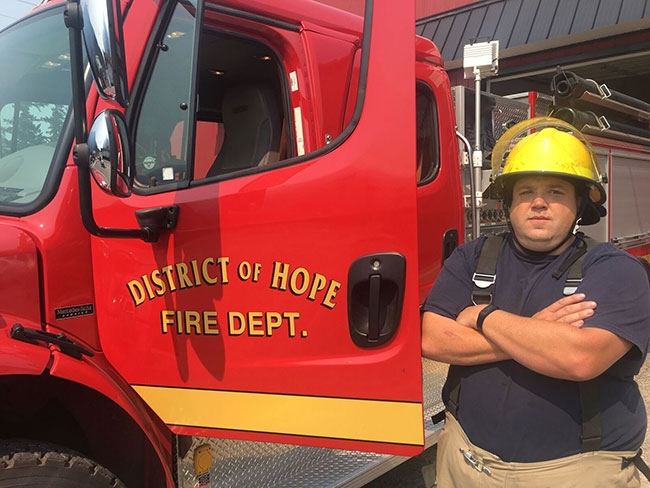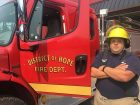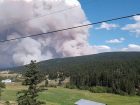
Features
Volunteers
Brotherhood and best practices: Learning the value of teamwork in Williams Lake
On July 11, Richard Wells, a volunteer firefighter with the Hope Fire Department in British Columbia, was sent to aid in structural-protection efforts in Williams Lake along with a colleague. Wildfires in the surrounding mountain area had the town on evacuation alert for two weeks prior to Wells’ arrival.
August 24, 2017
By
Lauren Scott
 Firefighters from municipal departments were deployed to various hot zones across the province over the summer. Firefighter Richard Wells tells assistant editor Lauren Scott how volunteer and career firefighters worked together to protect Williams Lake
Firefighters from municipal departments were deployed to various hot zones across the province over the summer. Firefighter Richard Wells tells assistant editor Lauren Scott how volunteer and career firefighters worked together to protect Williams LakeWells was greeted by grateful citizens, who were evacuated just days later, after 70 kilometres per hour winds hit the area. On July 27, residents were allowed to return home. By the end of July, more than 800 fires had burned across the province this season, destroying about 4,200 square kilometres.
Q: Walk us through your experience in Williams Lake, starting with when you signed up, to returning home to Hope six days later.
A: Well, the email came out and I thought, “Why not? I’ve got the experience.” It was nice to go help out another township. I didn’t really think much about it. I just signed up and said, “I’ll go if they need us.”
It was just one of those things that a town needed help, and I know how to fight fires. I’ve been doing it for 17 years, so I thought, “Why not sign up and go?”
Q: What was the six-hour drive like through wildfire-affected areas from Hope to Williams Lake?
A: It was definitely different, because normally there is lots of traffic on the roads. But because most of the road was closed, after we got past where the enclosure started, there was no traffic, [everything was] burned. Both sides of the highway were charred . . .
It wasn’t scary, it was just nerve-wracking seeing how much devastation has been through there and how much was burned. When you looked over to the sides [of the road] you could see the whole mountain had been burned, and then you’d see some hot spots every so often.
And it was like, “Wow this is actually happening.” And we’re going up to protect the town, when everything else we’ve already driven through has been devastated. So the first town we drove through had already lost all their stuff and we were going to protect a town to try and save their stuff.
Q: Did you have any expectations of what it would be like going into Williams Lake?
A: Just going there you saw the burning and you didn’t think it was this bad. And then once you got closer there were hot spots, and when it got dark then you could see flames in the bushes.
Almost every firefighter wants to see flames, but . . . forests are unpredictable. At least a structure is predictable – with the building the only way it can go is burn and come down; with a forest, [the fire] can jump and move, so you have to be extra careful.
I actually did forest fire fighting for a season when I was younger. So I actually saw it first-hand, so that’s why I wasn’t worried. I know a little bit, but I don’t know all the behaviours anymore, because it’s been so many years.
Q: What happened when you got to Williams Lake? What role were you given?
A: We got set up at the curling rink and . . . [we were told] the fire was still 18 kilometres away, [and to] go get some rest . . . and we would be briefed in the morning. So we had to sleep on a cot in the curling rink.
Q: What happened the next day?
A: So many crews showed up; I reckon there must have been something like 21 units show up that day and throughout the night. So they said “OK, what we’re going to do today is go around and familiarize yourselves with the town, get to know the [saw]mills,” because that was their biggest concern. I think they have four or five mills that they wanted protected because they said if they lost the mills, that’s basically the town’s livelihood…
You could see the smoke off in the distance but no flames because it was so far away.
Q: What did you see on that first day that you were driving around the town?
A: Well it still looked normal because the people were still there; they hadn’t actually evacuated yet. People were still driving around but then they started to notice more and more fire trucks. So everybody was starting to wave and they were happy to see us because they knew we were there to help. They were overwhelmed, but they were nice and pleasant, and everyone was waving, being thankful. They thanked us everywhere we went, for coming. We were like “Yeah no problem, we’re not the heroes, those are all the forestry guys that are doing the work; we are just here to help you guys.” They were happy to see us and they were a little more at ease that there were so many trucks in town. And they knew that we were there to help.
Q: What happened the following day?
A: The next day we were put in our groups. So we were paired up in task forces. There were five task forces and we were task force one, and that was Surrey, Vancouver, Sechelt, Coombs and [Hope]. There were two engines and three tenders.
The city guys, Vancouver and Surrey, they don’t deal with tenders, because they have all the hydrants and apparatuses, whereas us in rural towns, we have to use tenders to get the water. We had to go pair up with them and practise with our equipment together, so we could get used to running each other’s equipment. So we did a bunch of trials and then the next day . . . that’s when we were told [we would be stationed at] the mill.
We were watching for any ashes, anything falling. We stayed at the mill and drove around because there was so much sawdust, chips, lumber that we had to do patrols regularly just so there were no hot spots.
Q: How did the task force work together and what was your role?
A: It was actually interesting because it was neat to see their equipment and how it works, and we all got along great. It ran smoothly. There were no problems. Everybody [career and volunteer] acknowledged that they are all the same; there was no difference. It was actually really neat, and it was different for me because they’re full-timers and they were happy to be working with us.
Our tenders holds 1,500 gallons and they only hold 300 in their trucks, so basically we had to hook up to them, pump water into them so they could keep their engine flowing, because they’re the ones going to be putting out the hot spots with their hoses, whereas we have to keep them filled with water.
So we did drills where we had two trucks, two engines and two tenders set up and then we would shuttle the water to them, so we were testing to see how long it took.
So when we got that done, we were sent back to the mill every day and we just patrolled that mill. The mill that we were taking care of housed 350 employees, we found out. The mill manager said he doesn’t care about the office, he doesn’t care about the mechanics shop; it’s the mill. He said if they lose the mill, they won’t rebuild and then unfortunately it’s gone. So our biggest concern was the mill.
Q: What happened when the town was evacuated?
A: The wind was supposed to come on the Wednesday [July 12] and that’s why we all rushed up there on Tuesday. But then the forecast changed and the wind was coming Saturday [July 15]. And we were like “OK, it didn’t come Wednesday, let’s see what comes Saturday.”
Well Saturday it actually did pick up. The evacuation order came around . . . 2:30 [p.m.] or 3 o’clock . . .
When the wind picked up, the smoke got really bad. All of the sudden, three fires flared up around us. We noticed at noon when we looked up at the mountains . . . all of the sudden all three went up, and we looked up at the side nearest to the mill and said: “OK, we’ve got to go.” So all of us jumped into our trucks, our five-man crew team, and we took off to get to the mill.
That’s when we started noticing more ash falling on us because we were just sitting by the trucks and you could see it all just landing all over our truck and all over us. The smoke was so bad in the morning every day, but the day of the wind it was really bad, and you’d have a hard time breathing with your masks on.
So we were waiting until about 1:30 in the morning and finally we said, “Stand down, we’ve got a night crew that’s going to watch, they’re going to patrol the area to make sure [the wildfire] doesn’t come [into the town] and if it does come, be ready to come back out.”
Fortunately, nothing happened that night; we got to sleep.
Then Sunday, we went back to the mill to make sure [it was not affected]. In the morning we were talking to some other guys that were in the crew and they showed us that a couple of barns on the outskirts got burned, and a house was saved. So, [the fire?] did come close to town, but it didn’t quite get to us, which was fortunate . . .
So Sunday, we just patrolled because the fire was slowly moving, but overnight it didn’t move much. So we didn’t actually have to do anything.
On Monday came my replacement, which was difficult because I had become friends with the other crews.
Q: What was it like to be a crew member in Williams Lake on evacuation day?
A: It was a ghost town; it was definitely different. Nothing was open, not even a gas station. But then they did open [a gas station] on Sunday for us so we could get fuel . . . A lot of the town [residents] did leave on their own before, so there were not a lot of people [to start with] but then all of the sudden it went to nothing.
To drive around and see everywhere closed and police everywhere, it was definitely different. It’s nothing something you see and you don’t expect, because you always have people around you . . . I live in a small town of 8,000, but there are still always people. For these people to have to leave their homes like that is probably difficult.
Q: This was your first deployment; what was it like for you to experience?
A: It was nice because I got to help people . . . It was just nice that we were able to help another community. We went through Ashcroft and we saw that they lost a lot of their homes and [in Williams Lake] we had the chance to help somebody and that’s what we were there for. I’m glad I got the chance to try it, and even though nothing happened, I’m happy to for the opportunity.
Q: Your chief, Tom DeSorcy, has said he sees wildfire response as a great training opportunity for volunteers. What did you learn during your time in Williams Lake?
A: Working with other departments you’re going to learn different apparatuses. We have our own equipment at home, which is completely different from city equipment . . . So, to go there, to learn about their equipment and also to watch how busy the people that are actually fighting the fires are . . . whereas at a structural fire, you have the chief, he’s taking care of everybody, while these guys are trying to maintain a whole city, patrol it and save it.
There’s more to it, you have to learn the routes, the safety, the crews that are there, all the people that are there and how to maintain them and make sure that everybody comes back safe. So there’s a lot more to it than just, “Here, take the truck and go.”
So it was definitely an eye-opener as to how busy it is, how much work it takes and how much training everybody needs.
I think by the time I left, there were almost 40 units . . . But that’s just what they do; people called, so people came. And that’s just the way it is. It’s a brotherhood thing; people call, we’ll help.
Print this page
Advertisement
- Co-ordinated effort: Crews in British Columbia manage wildfires with mutual-aid system
- Firelines: Embracing a new generation of firefighters

